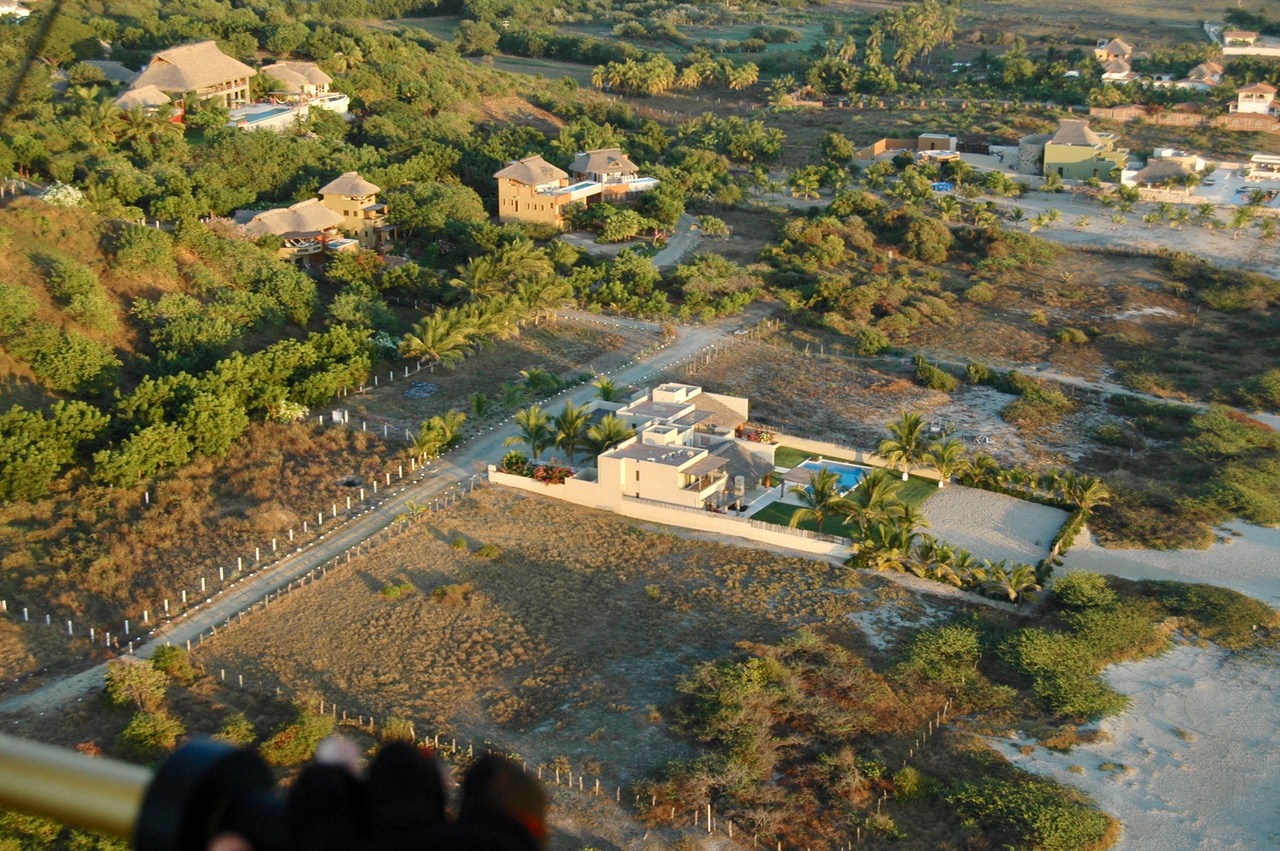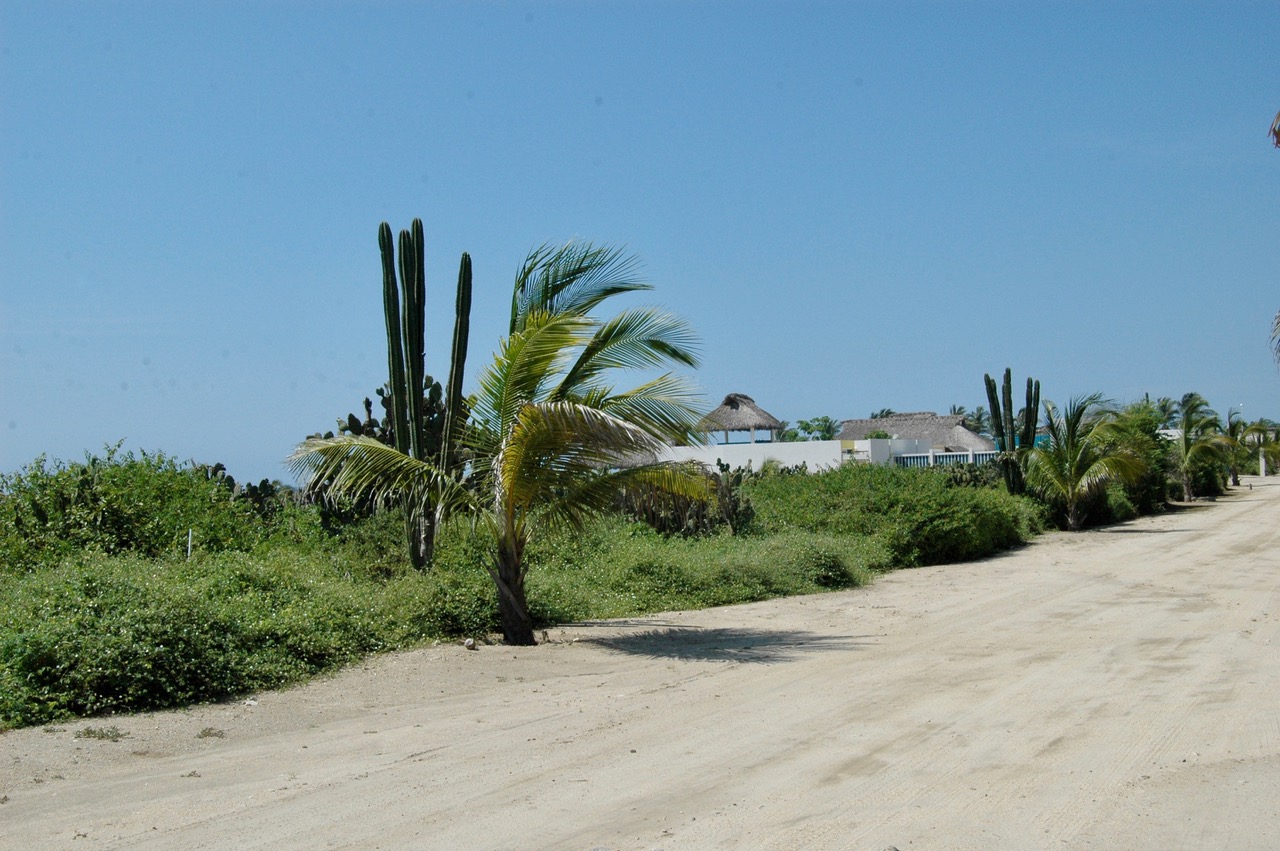
Real Estate In Paradise
I froze as the young man with the machete approached me on a deserted country lane just one block from Zicatela beach on a lovely Sunday morning. “Pardon me,” he said, “would you be interested in buying this lot?” — pointing to the land on which he had been working.
Welcome to Puerto Escondido where shopkeepers, taxi drivers and the friendly fellow in the bar (who is as likely to be a foreigner as a Mexican), all seem to have properties for sale. Of course, the properties aren’t really theirs, they are just angling for a commission.
Welcome to the land of the middle-man (comisionista). Everywhere you go there are lots for sale, some signs say “by owner”, but are they?
It is so easy to fall in love with Puerto Escondido. You are sitting on the terrace of a beachside restaurant enjoying a margarita or two and thinking, “I could live here.” And you can. I bought my land and built my house in 2005 and have never regretted my decision. But I know people who were not as fortunate, who fell victim to hustlers (yes, there are snakes in our paradise) and lost money on nefarious real estate deals or even honest ones where the buyer did not understand the market or the laws. The number one complaint of real estate lawyers in Puerto is that their clients will not listen to them when they explain the costs and risks of buying land here, and then later these same clients blame them when things turn out badly.

LOCATION, LOCATION, LOCATION
Note: prices shown below are based on reports of recent sales.
A lot of what we call Puerto Escondido really is outside the town limits, and even the part that is in the town is divided between two municipalities, each with its own laws regarding buying real estate. Worse yet, the two municipalities — San Pedro Mixtepec and Santa María Colotepec are in a decades-old conflict as to who controls what.

Bacocho, Rinconada, and Carrizalillo — on the western end of the town, near the airport — are in San Pedro Mixtepec and are favored by many Mexicans and foreigners. The lots are relatively small, around 300 m2, but there are many shops and restaurants in the area. Also, you can often get broad-band internet in Bacocho and Rinconada. Lots in Bacocho and Rinconada sell for upwards of $105 U.S. ($2,000 pesos) m2. In Carrizalillo it is around $300 U.S., much more for ocean-front properties.

The Punta de Zicatela, (Brisas de Zicatela) in Colotepec is also very popular. But its history of land disputes makes ownership there more problematic, and realtors tend to avoid the area.
Above Zicatela, on the hills on the north side of the highway, are the communities of Lázaro Cárdenas and Emiliano Zapata. There are many new developments there, like Linda Vista and Delfines.
The Barra de Colotepec is on the east side of the Punta. There are ocean-front properties and properties with ocean views. It’s a fast-growing area with lots in all price ranges.

Going east 20 minutes on the Coast Highway you reach Rancho Neptuno and Costa Cumaná. A 1,750 m2, ocean-front lot in Cumaná goes for around $150 U.S. m2, but the much larger properties one block from beach are $50 m2. Ocean-front lots in Neptuno cost around $110 m2.
There are no licensed real estate brokers in Mexico, but the three
most reliable realtors in Puerto are
Blue Horizon
http://bluehorizon.com.mx,
Puerto Real Estate
http://puertorealestate.com
and
Coco Realty
http://www.coco-realty.com/
Eloisa Monroy, (954) 158 7775, is an English-speaking lawyer
who specializes in real estate transactions. Alina Felix, Notaria #128,
(954) 582 0739, also speaks English.
WHY FOREIGNERS NEED A BANK TRUST (FIDEICOMISO)
Article 27 of the Mexican Constitution prohibits foreigners from owning property within 50 kms. of the coast. In 2013, the Chamber of Deputies voted in favor of a constitutional reform that would have allowed foreigners to buy land on the coast, but the bill was never considered by the Senate. There is no reason to believe that this provision of the constitution will be changed.
Foreigners are, however, permitted to possess land inside the restricted zone through a land trust administered by a bank. The trust (fideicomiso) has a 50-year duration and can be renewed. Although the bank holds the title to the property, it does not own it, nor is it responsible for liens or property taxes or irregularities that may cause the loss of the land. Fideicomisos costs around $2,500 U.S. to set up, in bank fees alone, and around $500 U.S. a year to maintain.
To get a fideicomiso you must have clear title (escritura pública) to your property. All the land in Bacocho, Rinconada, Carrizalillo, and adjacent communities are considered private property and have escrituras. The communities of Santa María, Tamarindos, and Lázaro Cárdenas are more problematic, but some of the properties in Lázaro Cárdenas do have escrituras.
CLEAR TITLES (ESCRITURAS PÚBLICAS) VS ACTAS DE POSESIÓN
The Federal Government, through local districts, issues titles (escrituras públicas) on private property. But, most of the land in the state of Oaxaca, including part of Puerto Escondido and its neighboring communities, is not administered by the federal government and is not considered private property. In these areas, known as communal land, there are no property titles, but rather actas de posesión issued by the local land offices (bienes comunales). If you are a Mexican national, having an acta offers the same protection as having a deed.
COMMUNAL LAND
The communal lands of San Pedro Mixtepec and Santa María Colotepec are but two of the 1,602 legally constituted communal and ejido lands in Oaxaca. Every three years a new president and commissioners are elected by the comuneros to administer the property of each bienes comunales. This commission is entirely independent of the municipality. Indeed, many municipalities include two or more bienes comunales. (There are 570 municipalities in Oaxaca.)Actas de posesión cannot be issued to foreigners. Since all the land in the Punta de Zicatela, and almost all the land on the Coast until Huatulco, is administered by local communities, it is, in theory, impossible to have an escritura on a property there, and without an escritura you cannot have a fideicomiso.
In practice, however, many Mexicans do have escrituras for their properties on communal lands and many foreigners have fideicomisos. How is this possible? If you have an acta de posesión from Santa María Colotepec, you can get an escritura issued by the land office for the District of Pochutla, although it will cost you thousands of dollars. This escritura is an official document that is recognized by the banks that issue fideicomisos.
But there is a catch. The Tribunal Agrario in Oaxaca is the only court authorized to handle property disputes on communal land, and it only recognizes actas de posesión. On the other hand, having an escritura can be useful in cases of fraud.
HOW FOREIGNERS BUY PROPERTY ON COMMUNAL LAND
All property owners in condo communities like Cumaná and Rancho Neptuno have actas de posesión and escrituras. These communities reached an agreement with the Bienes Comunales of Colotepec whereby the names of the banks issuing the fideicomisos to foreigners were put on the names of the actas. Without having the acta, foreigners would not be able to sell their properties.
EJIDO VS. COMMUNAL LAND
Both are legally referred to as social land. An ejido is a federal land grant, often on the site of a former hacienda or plantation. Communal land is territory recognized as historically belonging to a specific, usually indigenous, community.The Bienes Comunales of Colotepec will issue actas de posesión to Mexican nationals and to Mexican corporations. A Mexican corporation can be wholly owned by foreign nationals but must have a Mexican administrator — usually an accountant. This is the safest route, and it’s the one recommended by the bienes comunales. It costs less to set up a corporation than it does to get an escritura from Pochutla and there is no need for a fideicomiso. But, as a corporation, you must show some business activity — like renting your house — and pay taxes.
PRESTANOMBRE (STRAW BUYER)
The quick and easy and probably most common solution, but also the riskiest option, is to pay a Mexican national to put a property into her name. This sounds insane, and it is. The straw buyer (prestanombre) is the legal owner of the property, and if he or his heirs or his estranged wife decides to steal it, there is nothing you can do. It is against Mexican law to act as a prestanombre, and any contract you make will be non-binding. The real buyer is put in the position of a renter.
An oral agreement is as good as the paper it is written on.










